Encouraging kids to engage in outdoor play helps them develop essential skills and love nature. Activities like rockhounding teach geology and respect for the environment. Off-road RC car fun improves problem-solving and creativity. Nature-inspired play, such as gathering pretend cooking ingredients, boosts sensory development. Designing outdoor play areas with sandboxes or obstacle courses promotes physical activity and coordination.
Blend imaginative play with nature through ‘Barbie in the Wild’ adventures. Encourage creativity with leaf rubbings or rock painting. Bird-watching, nature scavenger hunts, and camping help kids observe and work as a team. Water exploration, crafting, and nature travel enhance overall development. Discover more ways to make kids’ outdoor play fun and enriching!
Key Takeaways
- Engage in rock hunting to discover and collect minerals, gems, and fossils while learning about geology.
- Create a sand-filled play area with treehouses and obstacle courses to promote physical activity and imaginative play.
- Use remote control cars on rugged terrains to enhance problem-solving skills and creativity.
- Organize nature scavenger hunts to encourage teamwork, problem-solving, and outdoor exploration.
- Plan bird-watching activities to develop observation skills and appreciation for wildlife.
Rockhounding Adventures
Rockhounding adventures provide children with a remarkable, hands-on opportunity to learn about geology by collecting mineral specimens, semi-precious gems, and natural fossils. This engaging activity sparks curiosity and encourages children to explore nature responsibly. Families on rockhounding trips must check land ownership regulations to ensure they collect in permissible areas, promoting respectful and sustainable practices.
Engaging in amateur geology activities such as rockhounding offers valuable educational experiences. Children can learn about different rocks and minerals, understanding their formation and significance. This hands-on approach to learning fosters a deeper appreciation for the natural world and can ignite a lifelong passion for geology.
Moreover, rockhounding trips can be a delightful way for families to bond while cultivating a love for outdoor exploration. Searching for and identifying geological treasures teaches patience, critical thinking, and observational skills. As children uncover the hidden wonders of the earth, they develop a tremendous respect for the environment and the importance of conservation.
Off-Road RC Car Fun
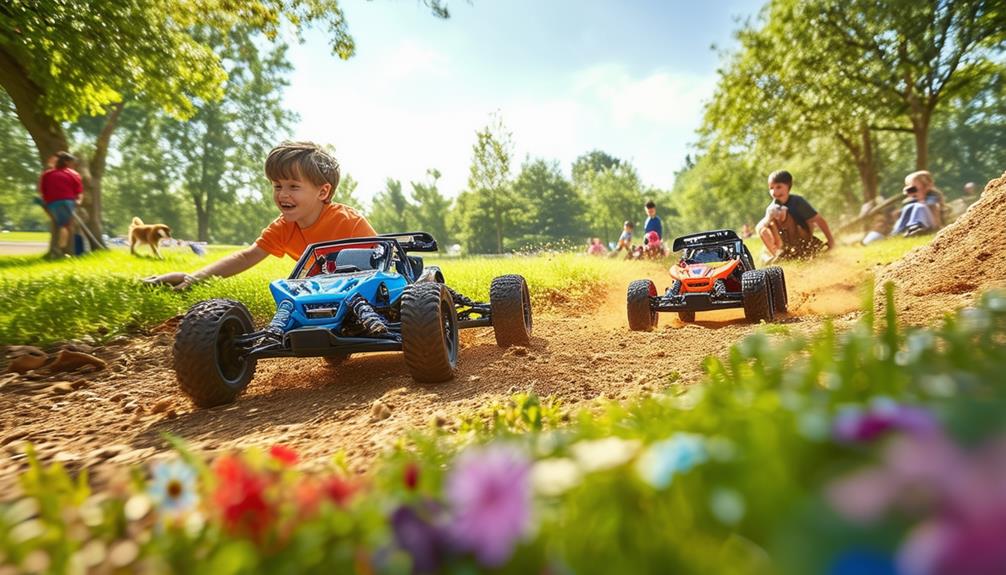
After exploring the wonders of geology through rockhounding adventures, children can further enhance their outdoor experiences by engaging in the thrilling activity of off-road RC car fun. This dynamic form of outdoor play involves using remote-controlled cars designed for rugged terrains, providing an exciting and adventurous way for kids to spend time outside.
Engaging in off-road RC car play in parks or open spaces allows children to improve their tactile experiences and fosters a sense of exploration. Children have fun and critical problem-solving skills and creativity by designing and maneuvering challenging terrains. Controlling RC cars’ hands-on nature helps enhance coordination and fine motor skills, making it a valuable developmental activity.
Moreover, this form of outdoor play encourages a love for nature and adventure. Kids are motivated to explore their surroundings, fostering an appreciation for the natural environment. Off-road RC car fun promotes physical activity, as children often run alongside their cars, enhancing overall fitness.
Incorporating off-road RC car fun into regular outdoor playtime offers a distinctive and thrilling experience, proving an excellent way to get kids excited about spending time outdoors.
Play Camp Kitchen
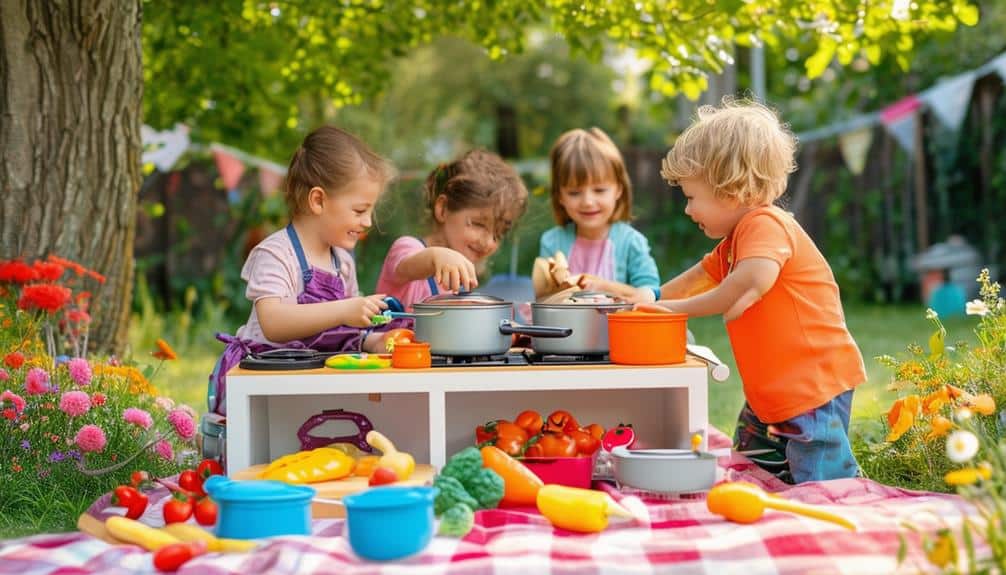
Creating a play camp kitchen is an excellent way for children to gather natural ingredients and engage in pretend cooking fun. This activity stimulates creativity and sensory development and promotes hands-on learning with natural materials. By encouraging imaginative storytelling and role-playing, outdoor play kitchens provide children memorable and enriching experiences.
Gather Natural Ingredients
Engaging children in gathering natural ingredients for a play camp kitchen stimulates their imagination and promotes hands-on learning and sensory exploration. Playing outside in nature becomes an immersive experience as children collect items like leaves, twigs, flowers, and pebbles. These natural materials are the perfect ingredients for their imaginative culinary creations, enhancing their connection to the environment.
Research indicates that outdoor play is vital for child development. It offers opportunities to build fine motor skills and improve cognitive functions through tactile experiences. Gathering natural ingredients encourages children to observe their surroundings closely, fostering a deeper understanding of nature’s resources. This activity also provides a platform for cooperative play, as children can work together to collect and categorize their finds, promoting teamwork and social skills.
Moreover, sourcing these natural items instills a sense of responsibility and respect for nature. Adults facilitating this activity can guide children on the importance of sustainable practices, such as not picking too many flowers or disturbing wildlife. By incorporating these lessons, children learn the value of environmental stewardship while enjoying the freedom and creativity of playing outside.
Pretend Cooking Fun
Building on the excitement of gathering natural ingredients, children can transform their collections into imaginative culinary masterpieces with a play-camp kitchen setup. Kids can create a distinctive space for creative play that fosters creativity and promotes sensory exploration and eco-friendly play by simulating outdoor cooking activities.
Setting up an outdoor cooking station can be as simple as using natural materials such as sticks, leaves, and mud. This type of play kitchen encourages children to engage with their environment in a hands-on, messy, and delightful manner. Here are some creative ideas to get started:
- Mud Pie Station: Utilize mud, sand, and water to create deliciously messy ‘pies’ and other pretend dishes.
- Leaf Salad Bar: Gather leaves, petals, and small twigs to mix up a vibrant, nature-inspired salad.
- Stick Skewers: Find sturdy sticks to use as skewers and pretend to grill various natural ingredients.
- Nature Soup Pot: Collect various natural items to combine in a pot for a hearty pretend soup.
Playing pretend cooking outdoors supports cognitive and sensory development while encouraging children to explore and appreciate the natural world. This enriching experience also allows children to practice teamwork, creativity, and problem-solving skills.
Create an Outdoor Play Area
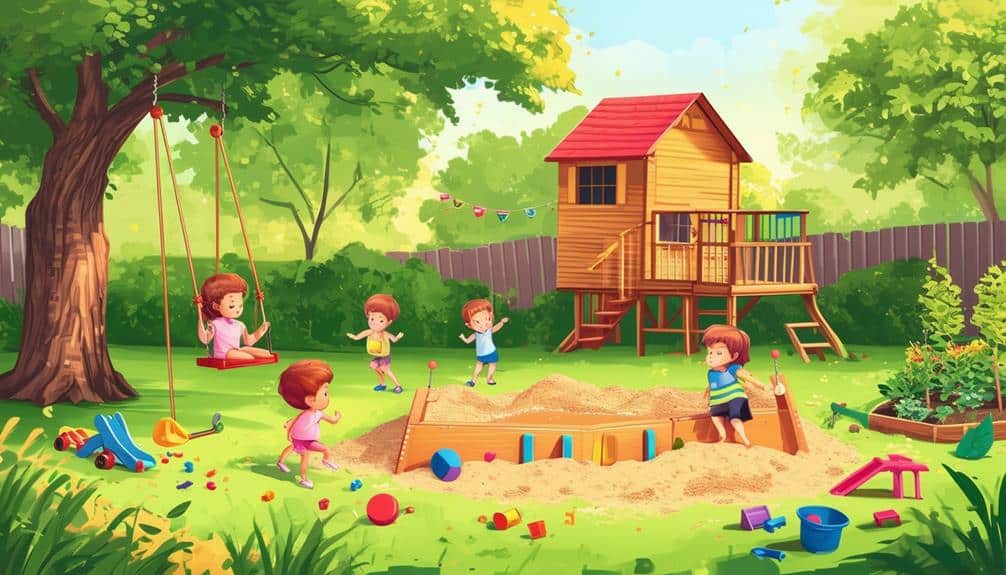
Designating a specific outdoor play area can significantly enhance children’s opportunities for physical activity, sensory engagement, and imaginative storytelling. Creating such spaces enables kids to spend more time outdoors, fostering development in many areas. Outdoor play areas can be tailored to include features such as sandboxes, playhouses, treehouses, mud kitchens, and obstacle courses. These elements provide diverse physical activities and stimulate sensory play and creativity.
Themed play areas, such as those designed for nature exploration, can enhance kids’ outdoor experiences. Constructing forts using natural materials like branches and leaves encourages imaginative play and problem-solving skills. Moreover, incorporating obstacle courses can help improve children’s coordination, strength, and agility.
| Play Area Feature | Benefits |
|---|---|
| Sandboxes | Sensory play, fine motor skills |
| Treehouses | Imaginative play, physical activity |
| Mud Kitchens | Creative play, sensory engagement |
Barbie in the Wild
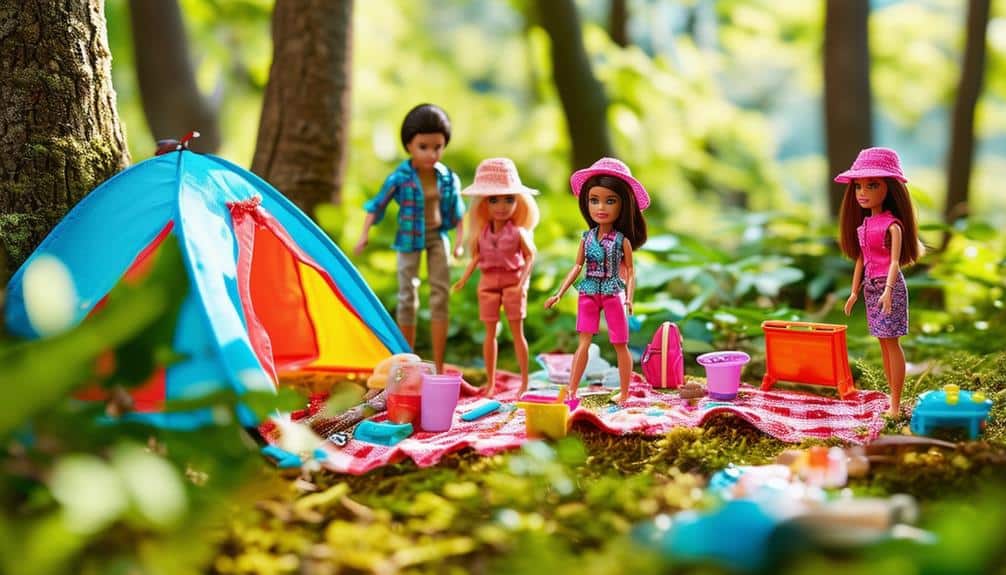
Barbie in the Wild allows children to blend imaginative play with outdoor exploration, enhancing creativity and a connection to nature. Kids can use their dolls to navigate mini hikes, picnics, and other nature-inspired activities by creating an Outdoor Barbie Adventure. Moreover, building a Nature-Inspired Playhouse can serve as a dynamic setting for storytelling and adventure, fostering a deeper appreciation for the environment.
Outdoor Barbie Adventure
Engaging in imaginative play through outdoor Barbie adventures offers children a remarkable opportunity to explore natural settings while fostering creativity and storytelling skills. Integrating Barbie into outdoor exploration can transform a simple outing into a vivid storybook adventure, blending play with nature appreciation. This method encourages children to spend more time outside and nurtures their cognitive and sentimental development.
To make the most of these outdoor Barbie adventures, consider the following ideas:
- Explore Local Parks: Take Barbie to nearby parks where children can create different scenarios, such as picnics or treasure hunts.
- Visit Nature Reserves: Introduce Barbie to diverse ecosystems in nature reserves, enhancing children’s understanding of wildlife and conservation.
- Forest Expeditions: Using forest trails as a backdrop for Barbie’s adventures allows children to build narratives around natural elements like trees and streams.
- Interactive Storytelling: Encourage kids to develop stories involving Barbie’s interactions with the environment, fostering creativity and a love for nature.
Nature-Inspired Playhouse
Building on the imaginative outdoor Barbie adventures, constructing a nature-inspired playhouse enables children to immerse themselves in the environment while fostering creativity and hands-on interaction with natural elements. This approach promotes an appreciation for the outdoors and enhances imaginative play by integrating natural materials, such as sticks, leaves, and stones, into the playhouse construction.
Creating a nature-inspired playhouse provides a structured yet imaginative way for kids to spend more time outside. It encourages them to explore their surroundings, gather materials, and think creatively about how to use these elements in their playhouse. This activity also supports developmental skills, including problem-solving, fine motor skills, and spatial awareness.
| Benefits | Activities Involved |
|---|---|
| Enhances creativity | Collecting materials |
| Promotes outdoor play | Constructing playhouse |
| Develops fine motor skills | Decorating playhouse |
Get Crafty Outdoors
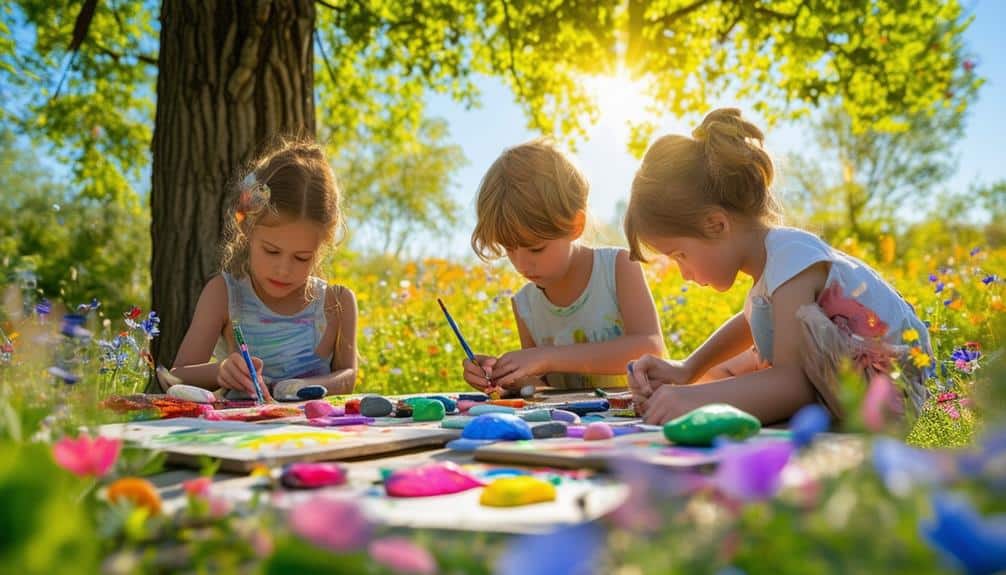
Outdoor crafting provides children with an excellent opportunity to explore their creativity while benefiting from the fresh air and natural surroundings. Engaging in nature-inspired crafts like leaf rubbings, rock painting, and flower pressing allows kids to spend time outside, encouraging a deeper connection with their environment. Crafting outdoors not only promotes sensory exploration but also enhances the development of fine motor skills and fosters an appreciation for nature.
Setting up a designated outdoor crafting area can significantly increase children’s willingness to spend time outside. This dedicated space becomes a haven for creativity, using natural materials to inspire and engage young minds. Incorporating sticks, pinecones, and flowers into crafts enriches the outdoor crafting experience, making it more tactile and visually stimulating.
Here are some fun and engaging outdoor craft ideas:
- Leaf Rubbings: Use crayons and paper to capture the intricate patterns of leaves.
- Rock Painting: Transform ordinary rocks into colorful masterpieces with paint.
- Flower Pressing: Preserve the beauty of flowers by pressing them into paper.
- Nature Collages: Create collages using found objects like twigs, leaves, and petals.
Go Bird-Watching
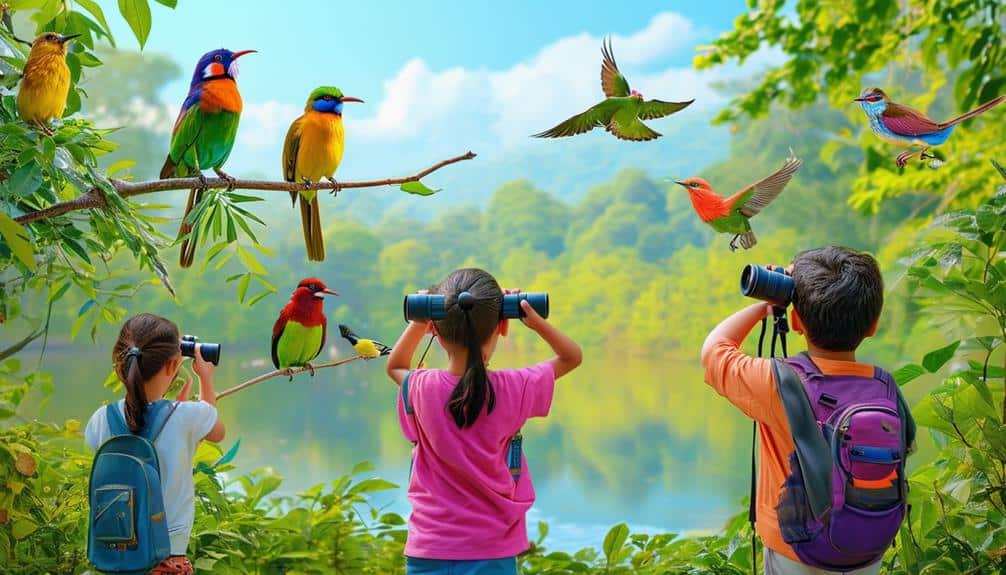
Bird-watching offers children a distinctive opportunity to spot local bird species while honing their observation skills. By using binoculars effectively, young bird watchers can closely examine bird features and behaviors, enhancing their identification abilities. This engaging activity fosters a deeper appreciation for nature and contributes to valuable citizen science projects.
Spot Local Species
Bird-watching enables children to develop their observation skills while learning about the diverse array of local bird species in their natural habitats. This activity fosters a profound appreciation for nature and biodiversity and provides a hands-on learning experience that promotes environmental stewardship among young participants.
Bird-watching can be incredibly engaging for children when they:
- Keep a bird-watching journal: Documenting the species they encounter helps track progress and note distinct behaviors.
- Participate in citizen science projects: Involvement in these projects can amplify their interest in environmental conservation and scientific inquiry.
- Learn bird calls and songs: Identifying birds by their calls adds an auditory element to the visual activity, enhancing their sensory engagement.
- Use field guides: These resources help children identify species accurately and learn about their habitats, diets, and migration patterns.
Use Binoculars Effectively
Utilizing binoculars allows children to observe birds in greater detail, enhancing their ability to identify different species and fostering a deeper connection with nature. Bird-watching with binoculars brings birds’ intricate patterns, vivid colors, and distinct behaviors, creating a more engaging and educational outdoor experience.
Bird-watching is an enjoyable activity and a powerful tool for developing observation skills. When children use binoculars, they are encouraged to focus intently, honing their attention to detail. This can lead to a greater appreciation for wildlife and the ecosystems birds inhabit. The magnified view provided by binoculars reveals the subtle intricacies of birds’ plumage and actions, sparking curiosity and a desire to learn more about avian habits and habitats.
Encouraging children to use binoculars for bird-watching also promotes a love for wildlife and the natural world. It nurtures a sense of responsibility toward preserving these environments, aligning with the values of those dedicated to serving others and the planet. To conclude, using binoculars for bird-watching is a multifaceted approach to outdoor education, fostering growth and environmental stewardship.
Spell With Sticks
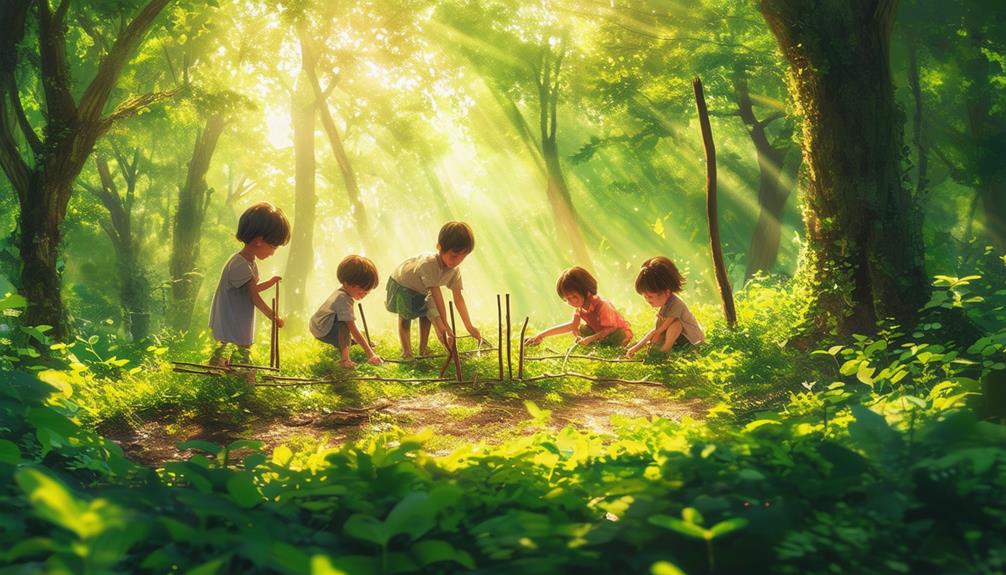
Spell with sticks is an engaging outdoor activity that combines the natural environment with educational benefits. It allows children to practice spelling and develop fine motor skills. This activity encourages children to spend time outside. It involves using twigs to write letters in sand or dirt, creating a sensory-rich experience that fosters learning and creativity.
Research indicates that integrating nature into educational practices enhances cognitive development and physical well-being. Through hands-on exploration, children interact with their environment meaningfully, making learning fun and effective. Kids use sticks to form letters to improve their spelling, alphabet skills, and fine motor coordination.
Key benefits of this activity include:
- Encourages outdoor play: Children become more active and engaged with nature by providing a reason to be outside.
- Promotes fine motor skills: Handling sticks to create letters helps develop precise hand movements.
- Stimulates creativity: Children can experiment with different shapes and forms, fostering imaginative thinking.
- Integrates learning and play: By blending educational tasks with outdoor play, kids experience a balanced and enjoyable approach to education.
Play Rock Music
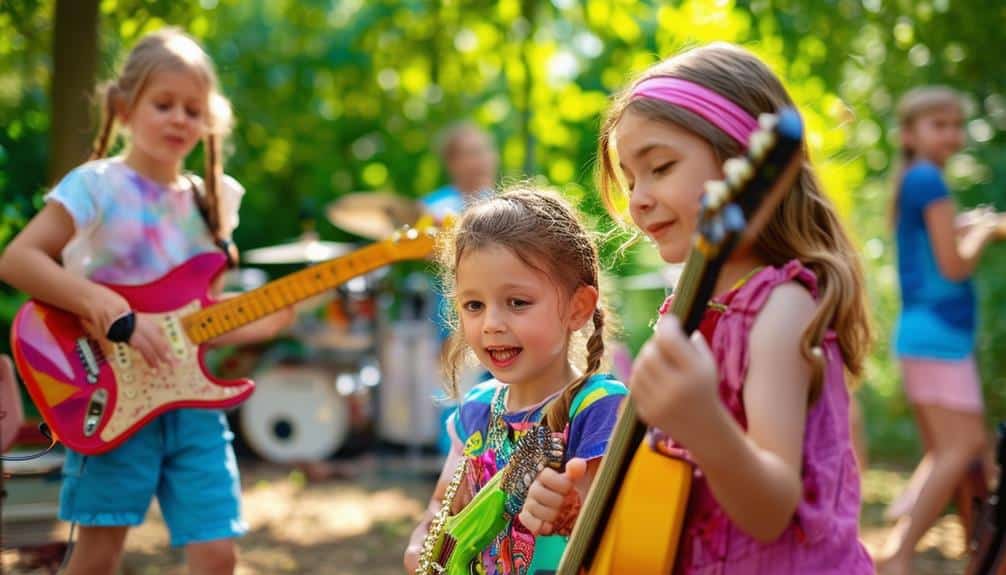
Creating music with natural items like rocks, acorns, and sticks offers children a unique opportunity to blend creativity with sensory exploration. Engaging in outdoor musical activities provides a fun way to spend time outside and promotes cognitive and motor skill development. By experimenting with the distinct sounds and rhythms that these natural elements can produce, children can learn to appreciate the diverse acoustics of the environment.
Encouraging kids to create songs and melodies using the outdoor elements they find can enhance their creative thinking and problem-solving abilities. This activity allows children to express themselves musically while developing an interest in the natural world. For instance, tapping rocks together or shaking a stick with acorns can help them understand rhythm and tempo, fostering musical and auditory skills.
Blending nature exploration with musical expression is an excellent developmental tool, inspiring a lifelong love for nature and music. Spending time outside in such creative pursuits can also improve children’s mental well-being, as they experience the calming and refreshing effects of interacting with nature. This holistic approach ensures that outdoor time is both educational and enjoyable.
Nature Scavenger Hunt
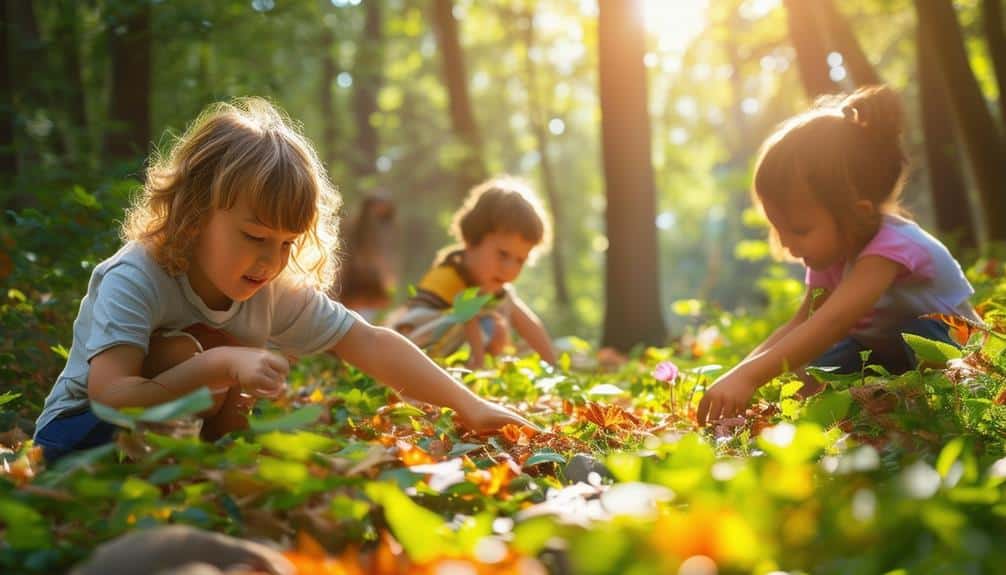
Nature scavenger hunt is an engaging activity that promotes teamwork, problem-solving, and observational skills in children while fostering a connection with the natural environment. By participating in these hunts, children actively explore their surroundings and learn to appreciate the diversity of nature. This activity can be tailored to various age groups and skill levels, making it an inclusive outdoor adventure.
A nature scavenger hunt typically involves children searching for specific natural objects such as rocks, leaves, or insects. Small prizes can be offered upon successful completion to make the experience more enjoyable and motivating. This adds an element of excitement and encourages children to engage fully in the task.
Key benefits of nature scavenger hunt include:
- Teamwork: Children work together to find items, enhancing their cooperative skills.
- Problem-solving: Figuring out where to find items fosters critical thinking.
- Observation: Sharpening the ability to notice details in the environment.
- Exploration: Encourages kids to explore and learn about local biodiversity.
For those who aim to serve others, organizing nature scavenger hunts can be a meaningful way to inspire children to value and protect the natural world around them.
Rough It Camping
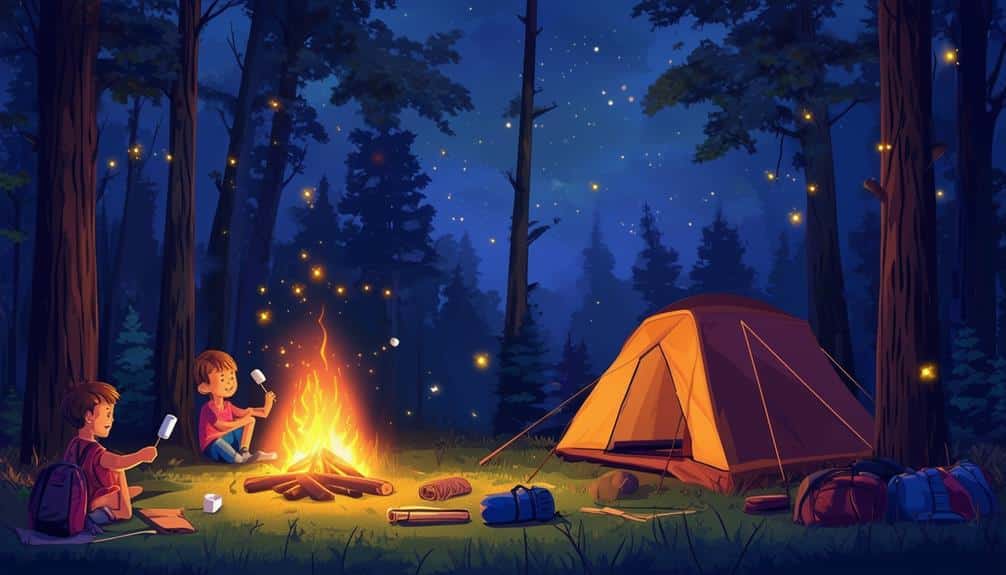
Roughing it, camping provides an excellent opportunity for families to bond while teaching children valuable life skills such as creativity, patience, and resourcefulness. Engaging in activities like gathering sticks for a campfire or toasting marshmallows instills a sense of accomplishment in kids and fosters a collaborative family environment. This shared time outdoors encourages teamwork and enhances family relationships.
Research indicates that outdoor experiences, such as camping, significantly promote physical activity and an appreciation for nature. These activities offer children a revitalizing break from screen time and structured indoor routines. By immersing themselves in the simplicity of nature, children learn to value the environment and develop empathy for wildlife, contributing to their overall social and relational development.
Furthermore, camping provides an ideal setting for children to explore their creativity. From setting up tents to cooking over an open fire, these hands-on experiences require innovative problem-solving and adaptability, essential for their growth and future endeavors.
Ultimately, roughing it, camping is not just a leisure activity but a developmental tool that nurtures essential life skills and strengthens family bonds. Investing time in these outdoor experiences can yield lifelong benefits for children and families.
Water Exploration
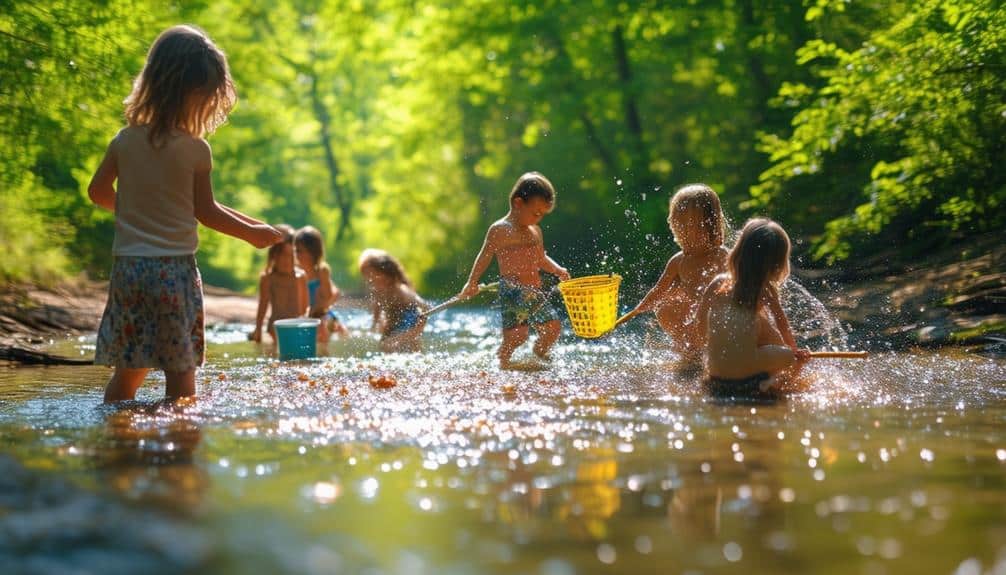
Building on the benefits of outdoor activities, water exploration offers children an engaging way to connect with nature while enhancing their sensory and cognitive development. Activities like beach outings, tide pool exploration, and visits to freshwater lakes provide rich, hands-on learning experiences that foster curiosity and environmental awareness. Research indicates that living near water bodies can significantly boost overall happiness and well-being, making it essential for children to spend time in these environments.
Water exploration allows children to experience diverse textures, sounds, and marine life, contributing to sensory development. Moreover, engaging in water activities can help improve motor skills, social interactions, and innovative problem-solving abilities. Here are some enjoyable and impactful water exploration activities for kids:
- Beach outings: Encourage sand play, swimming, and seashell discovery to stimulate creativity and physical activity.
- Tide pool exploration: Offer an exceptional opportunity to learn about marine ecosystems and observe sea creatures in their natural habitats.
- Freshwater lake visits: Provide a peaceful setting for swimming, fishing, and observing local wildlife.
- Backyard water games: A fun, refreshing way to enjoy outdoor play while fostering social skills and teamwork.
Plan Nature Travel
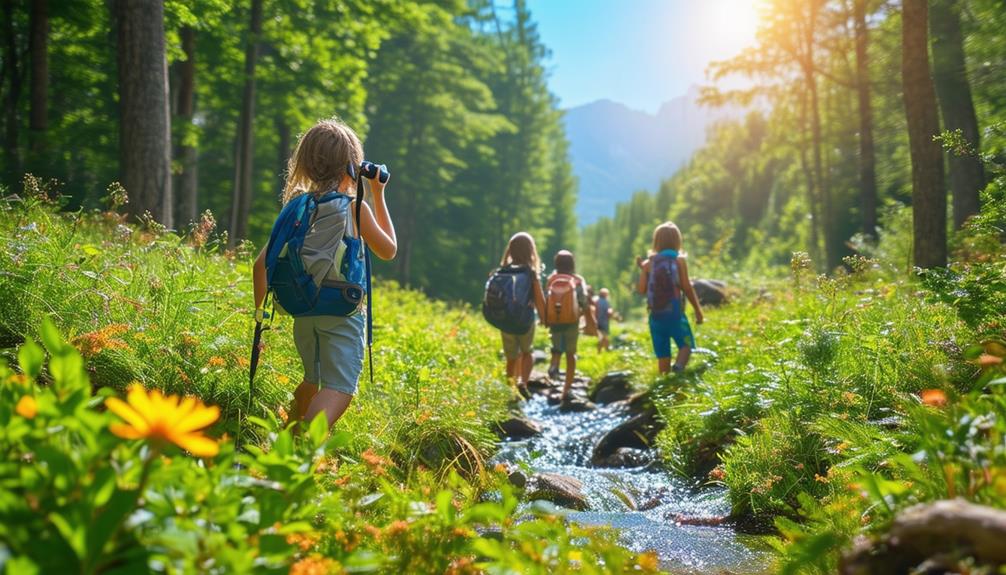
Planning nature travel allows families to immerse themselves in outdoor adventures that foster children’s physical development and lifelong appreciation for the natural world. National parks, such as the Grand Canyon and Yellowstone, offer various diverse outdoor experiences invaluable for children’s growth. Activities like hiking, rock climbing, and rafting promote physical fitness and enhance problem-solving skills and resilience.
National parks are ideal destinations for adventure vacations. Families can go skiing and snowshoeing in winter, while summer offers thrilling opportunities for whitewater rafting. These activities ensure that children remain active and engaged, benefiting their physical health and mental well-being. Additionally, experiencing natural wonders such as waterfalls, canyons, and geysers can spark a profound love for the outdoors in young minds, cultivating environmental stewardship.
Visiting these outdoor destinations creates lasting memories and strengthens family bonds through shared nature exploration. The immersive nature travel experience offers children a unique chance to connect with the environment, understand the importance of conservation, and develop a lifelong passion for outdoor activities. Families can enrich their lives by planning nature travel and instill essential values in their children.
Frequently Asked Questions
How Do I Get My Kids Outdoor Play More Often?
Ignite a child’s curiosity like a spark in a tinderbox by setting achievable outdoor goals, utilizing nature-based activities, and integrating outdoor play into daily routines. Engage in community programs to foster social interaction and sustained interest.
How Do You Make a Fun Day Outside?
Plan activities that blend exploration and learning to create an enjoyable day outside. Organize a nature scavenger hunt, engage in outdoor art projects, introduce gardening, enjoy a picnic with games, or explore bird watching with binoculars.
What Are Outdoor Activities for Children?
Outdoor activities for children include rockhounding, wildlife conservation, outdoor sports, gardening, art projects, and fort building. These activities foster physical activity, creativity, environmental awareness, and family bonding, promoting holistic developmental growth and nature engagement.
How to Spend More Time Outside as a Family?
Studies show that families who spend at least 20 minutes outdoors daily report 50% improved mental well-being. Prioritizing outdoor family time through activities like hiking, biking, and nature journaling fosters environmental awareness and promotes a healthier lifestyle.
Conclusion
In summary, encouraging outdoor activities like rockhounding, off-road RC car adventures, and nature scavenger hunts is essential for a child’s growth. Pediatric occupational therapists and physical therapists encourage kids to play outdoors to boost physical health and social skills. Simple games like blowing bubbles, playing with sidewalk chalk, or using a piece of chalk for hopscotch can make outdoor time fun and engaging.
Parents can find many fun games for kids to help them enjoy the outdoors. Classic park games like Marco Polo, tennis ball toss, or ping pong can keep kids active and happy. Using nature items to create art or organizing water games with a garden hose can provide hours of fun. Activities for kids, like painting rocks with acrylic paint or playing a game of basketball, can help develop various skills while having fun.
Creating a childhood full of outdoor adventures is vital. Pediatric occupational therapists and physical therapists recommend kids’ outdoor play to support overall development. Organize simple games like “Red Light, Green Light,” or set up a pool in the backyard for water games with pool noodles. Even everyday items like colored pencils and cardstock paper can become fun outdoor games. By incorporating these fun activities, parents can help children build a lifelong love for the outdoors.

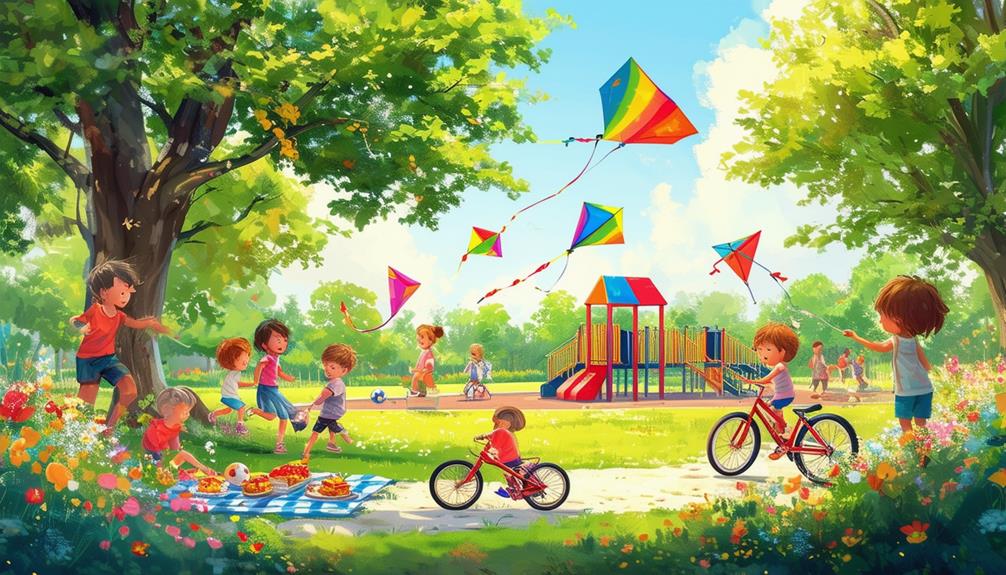
Recent Comments